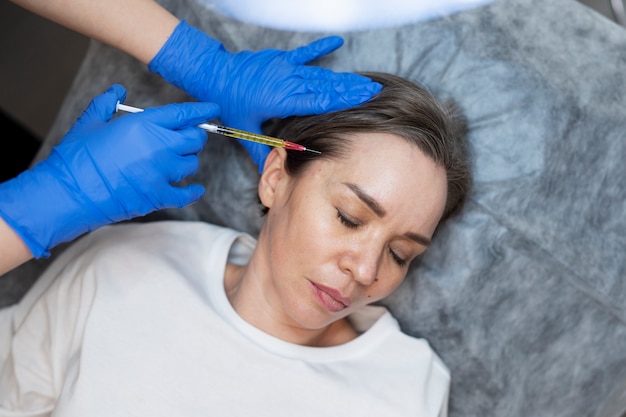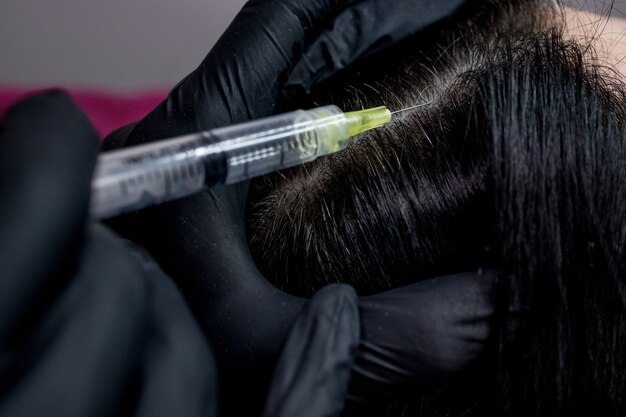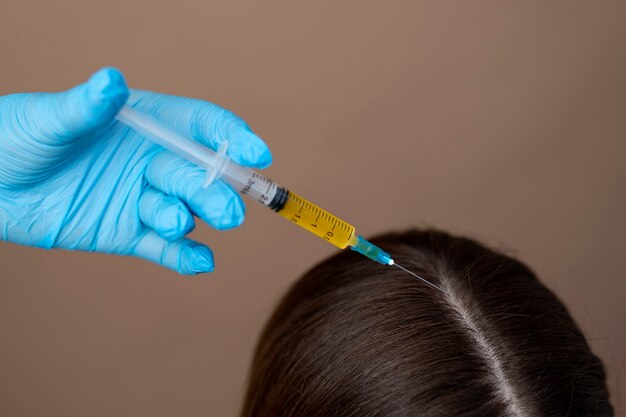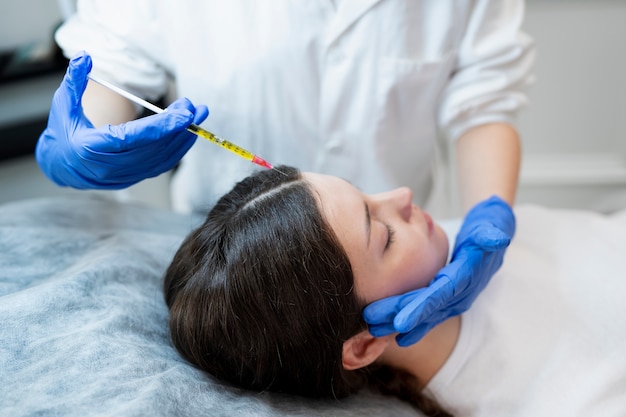Introduction
If you’re looking into PRP (Platelet-Rich Plasma) hair treatment, you’ve come across some strange claims. While PRP has gained popularity for treating hair loss, it’s surrounded by misconceptions that can make it hard to figure out what’s real and what’s just noise. Best PRP Hair Treatment in Islamabad, Pakistan Let’s set the record straight and bust five common myths about PRP hair treatment that you definitely shouldn’t believe.
Myth #1: PRP Hair Treatment Is Only for People with Severe Hair Loss
A lot of people think PRP is just for those who have completely lost their hair. Not true. PRP is most effective for those in the early stages of hair thinning. If you’ve noticed some receding or thinning, PRP can help slow it down and even encourage new growth.
Here’s the thing: PRP works by stimulating your hair follicles with growth factors from your blood. If you’re beginning to notice a little thinning, now is the perfect time to act. In fact, exploring the Top Benefits of PRP Hair Treatment in Islamabad can give you a clearer picture of how effective this approach can be. Remember, the earlier you start, the better the results.
Now, if you wait until you’re already nearly bald, PRP won’t be as effective. But for anyone with early or moderate hair loss, it’s a great tool to have in your corner.
Dr. Taskeen Iqbal offers PRP hair treatments tailored to each stage of hair loss so you can find the right plan for you.

Myth #2: PRP Hair Treatment Is a One-Time Solution
Another myth is that PRP is a magic fix that works in one session. If only it were that simple, right? The reality is that PRP is a process that requires multiple treatments. PRP vs Other Hair Loss Treatments: Why Choose PRP? Think of it like this: you wouldn’t expect to see drastic muscle growth after one workout—hair growth works the same way.
For optimal results, most people need 3 to 4 sessions spaced about a month apart. After that, maintenance treatments are required every 6 to 12 months. It’s a long-term commitment, but it’s well worth it if you want thicker, healthier hair.
So, don’t expect a miracle in just one session. But if you stick with it, the gradual results are absolutely worth the wait.
Dr Taskeen Iqbal will help you plan the best treatment schedule for your hair and ensure you get the results you want.
Myth #3: PRP Hair Treatment Is Painful and Invasive
Another common misconception is that PRP involves a lot of pain. People hear “injections” and immediately think of discomfort. But the truth is, PRP is way less invasive than people imagine.
Before the injections, your scalp will be numbed with a local anaesthetic so that you won’t feel much at all during the procedure. The blood draw, which is just like a regular blood test, takes only a few minutes. Then, the platelet-rich plasma is processed and injected back into your scalp, which only takes about 20 minutes. Most patients describe the sensation as mild discomfort at most.
Afterwards, you may notice some redness or swelling, but that’s common and goes away after a few hours. It’s a simple and quick procedure with minimal downtime.
Dr. Taskeen Iqbal makes sure you’re as comfortable as possible and explains everything beforehand so you know exactly what to expect.

Myth #4: PRP Hair Treatment Works for Everyone
As much as we all wish there were a one-size-fits-all solution for hair loss, PRP isn’t for everyone. It works best for people who still have active hair follicles. If your hair follicles are already dead or severely damaged, PRP won’t be able to help.
PRP works by encouraging your existing follicles to grow stronger and thicker. If your follicles are too far gone, it just won’t be effective. So, suppose you’re dealing with a condition like scarring alopecia, which destroys the hair follicles. In that case, PRP won’t give you the desired results.
That’s why it’s essential to get an evaluation first to determine whether PRP is the right option for you.
Dr. Taskeen Iqbal will assess your hair loss and help determine whether PRP is the best option or if another solution might be more suitable.
Myth #5: PRP Hair Treatment Provides Instant Results
Here’s another myth that trips people up: the idea that PRP will give you thick, luscious hair overnight. Sadly, that’s not how it works.
PRP is a gradual process. While some people see slight improvement within a few months, it usually takes around 3 to 6 months before you notice a real difference. Full results often take up to a year. This can feel like a long time, but trust me, it’s worth it when you see the changes.
PRP isn’t about a quick fix; it’s about long-term results that get better over time. It works by stimulating your hair follicles and improving scalp health, which leads to more natural hair growth. It’s a process, but the results speak for themselves.
Dr. Taskeen Iqbal helps set realistic expectations and walks you through the entire process so you’re never left in the dark about your progress.

Why Choose Dr. Taskeen Iqbal for PRP Hair Treatment in Islamabad?
You might be wondering: Why Dr. Taskeen Iqbal? Well, aside from being an expert in PRP treatments, she takes a personalized approach to each patient. There are no cookie-cutter treatments here. She works with you to find the best plan based on your hair loss and goals.
Dr. Iqbal also uses the latest equipment and techniques to ensure that every session is as effective as possible. You’re not just another patient on a long list—she truly cares about your results.
Whether you’re experiencing the early stages of hair loss or more advanced thinning, Dr. Taskeen Iqbal offers treatments that can help restore your hair to life.
Book a consultation with Dr. Taskeen Iqbal and get started on your journey to healthier hair!
What to Expect During a PRP Hair Treatment Session?
What happens during a PRP session? Here’s a quick breakdown:
First, you’ll have a consultation to discuss your hair loss and whether PRP is the right solution for you. If you decide to move forward, the process starts with a blood draw from your arm. Don’t worry—it’s just like any regular blood test and takes only a few minutes.
Next, the blood is processed to separate the platelet-rich plasma, which is the good stuff. This plasma contains growth factors that help your hair follicles grow stronger. The plasma is then injected back into your scalp, focusing on the areas where hair thinning is most noticeable. The entire procedure typically takes 30 to 45 minutes.
After the session, you might see some mild redness or swelling. Still, it’s nothing major and usually disappears within a few hours. Best of all, there’s no downtime, so you can go right back to your routine.

The Benefits of PRP Hair Treatment: Why It’s Worth It
PRP offers plenty of benefits that make it an excellent option for people struggling with hair loss. Here’s why it might be worth your time:
- It’s natural: Because PRP uses your blood, there’s no risk of allergic reactions or unwanted side effects. It’s an entirely natural way to stimulate hair growth.
- No surgery: Unlike hair transplant surgery, PRP is non-invasive and doesn’t require any cutting or stitching. It’s a much easier procedure with minimal downtime.
- It’s practical: PRP has been shown to help boost hair growth and improve hair thickness and quality.
- Minimal side effects: Most patients only experience mild redness or swelling around the injection sites, which usually goes away quickly.
PRP is a great, natural option for anyone looking to restore their hair without undergoing surgery or using harsh chemicals.

Conclusion
PRP hair treatment is a fantastic option for many people struggling with hair loss. Still, it’s essential to clear up the myths so you can make an informed decision. While it’s not a one-time miracle or a solution for everyone, PRP is a natural, non-invasive treatment that works best when started early.
If you’re in the early stages of hair loss, PRP can help slow down the thinning process and even stimulate new hair growth. And while results aren’t immediate, with patience, PRP can give you thicker, healthier hair over time.
If you’re ready to take the first step toward restoring your hair, Dr. Taskeen Iqbal is here to guide you. She’s an expert in PRP treatments and will work with you to create a treatment plan that fits your needs.
Contact Dr. Taskeen Iqbal to schedule a consultation and start your journey toward fuller, healthier hair today!
FAQs
What are the negatives of PRP?
While PRP is generally safe, some people may experience mild swelling, redness, or temporary discomfort at the injection site. In rare cases, it may lead to infection or allergic reactions. Dr. Taskeen Iqbal ensures the procedure is done with precision and care to minimize such risks.
What causes PRP to fail?
PRP may not be effective if the hair follicles are too damaged or inactive or if the patient doesn’t follow the recommended treatment plan. Dr. Taskeen Iqbal evaluates your scalp condition to determine if PRP is the best solution for you.
Who should avoid PRP?
People with certain blood disorders, active scalp infections, or autoimmune diseases should avoid PRP. Dr. Taskeen Iqbal conducts thorough assessments to ensure that PRP is suitable for each patient’s health condition.
Is there evidence for PRP in hair?
Yes, numerous studies show PRP can promote hair growth and improve thickness for people with androgenetic alopecia and other types of hair loss. Dr. Taskeen Iqbal stays updated with the latest research to offer the best results for her patients.
Is PRP better than GFC?
PRP and GFC (Growth Factor Concentrate) both use blood-derived components to stimulate hair growth. Still, GFC is considered a more refined treatment. Dr. Taskeen Iqbal helps you choose between PRP and GFC based on your specific hair needs.
Why am I losing more hair after PRP?
Some patients experience shedding during the initial PRP treatments as the hair follicles transition into the growth phase. Dr. Taskeen Iqbal explains this process and assures that temporary shedding is a normal part of the treatment.

